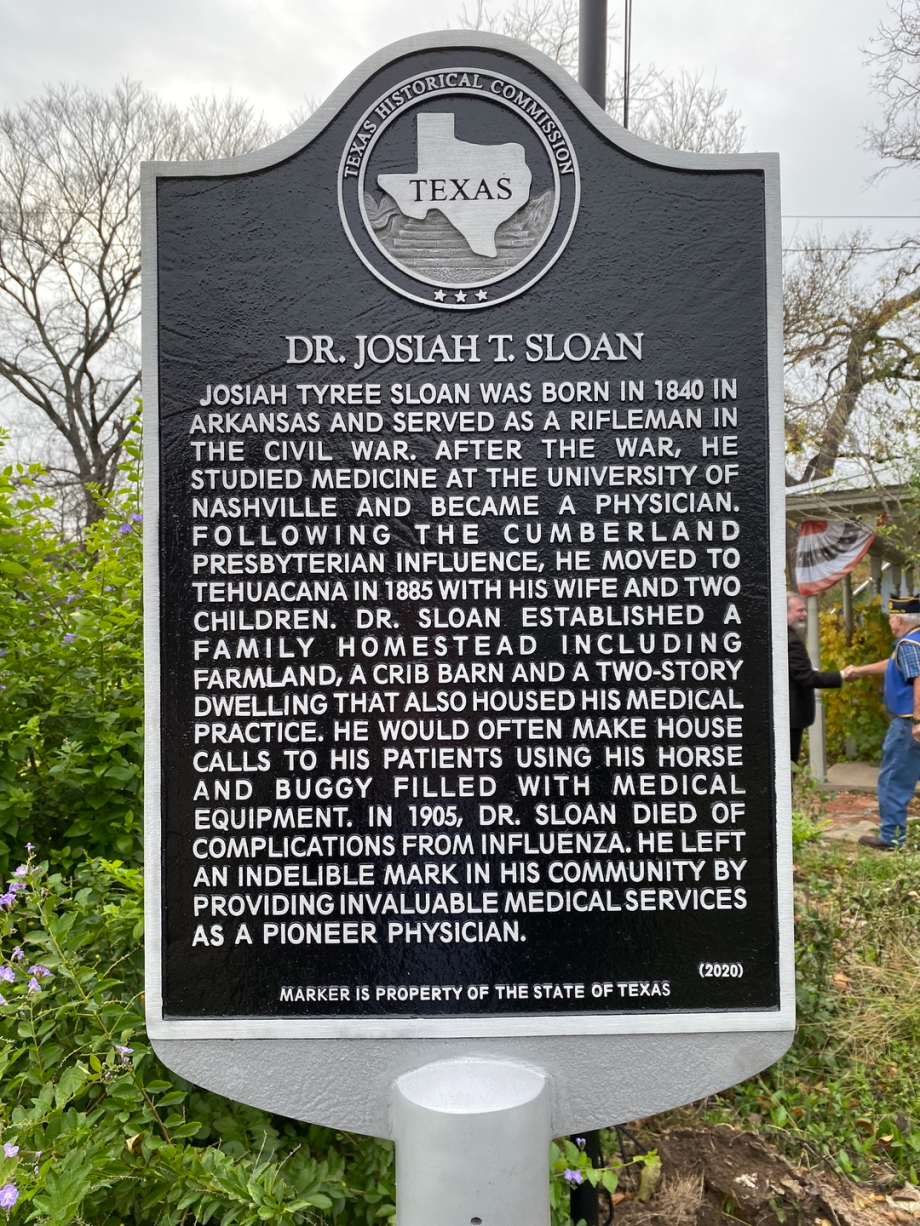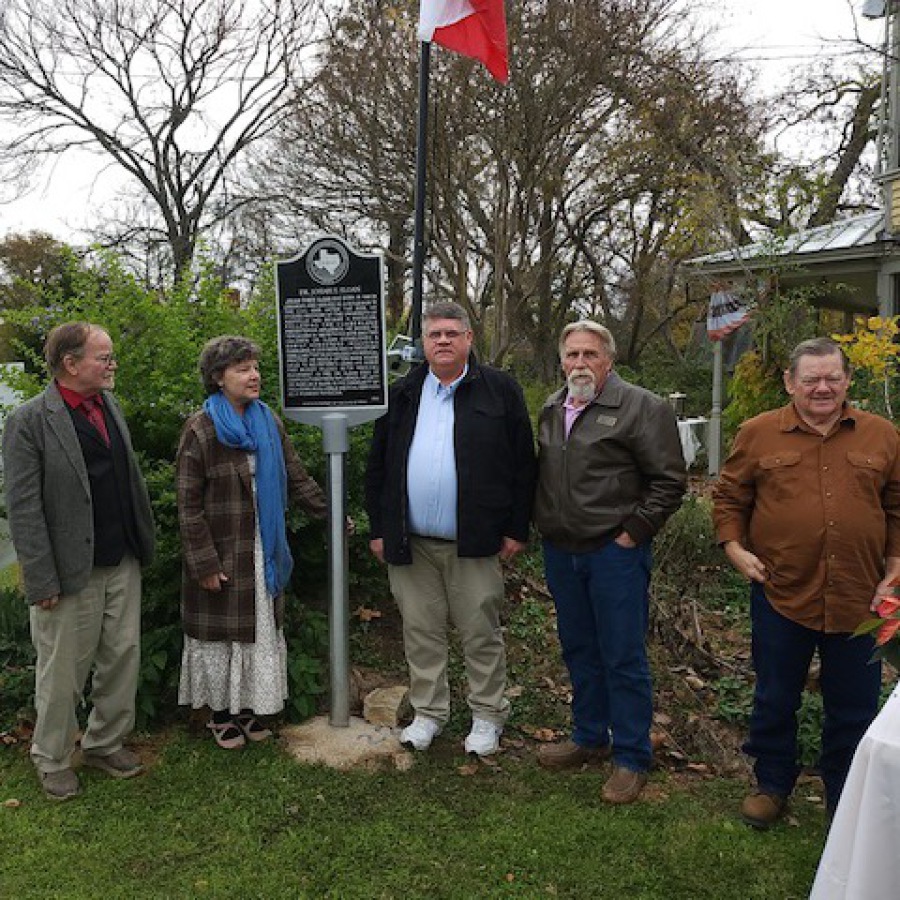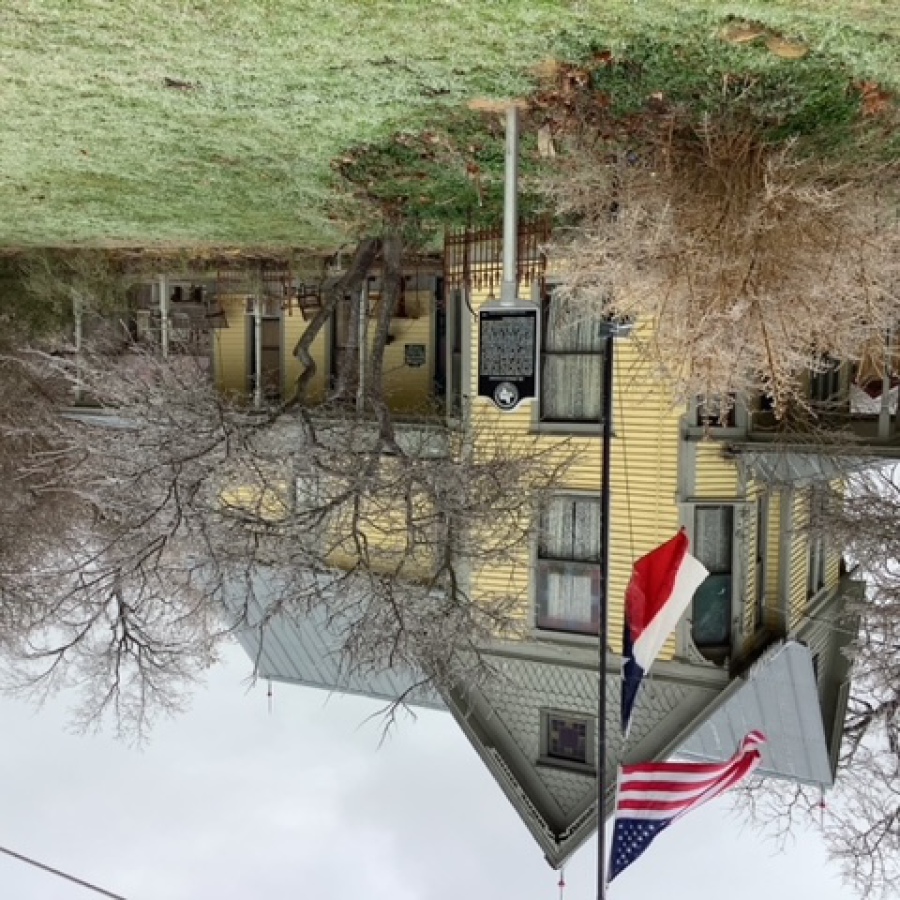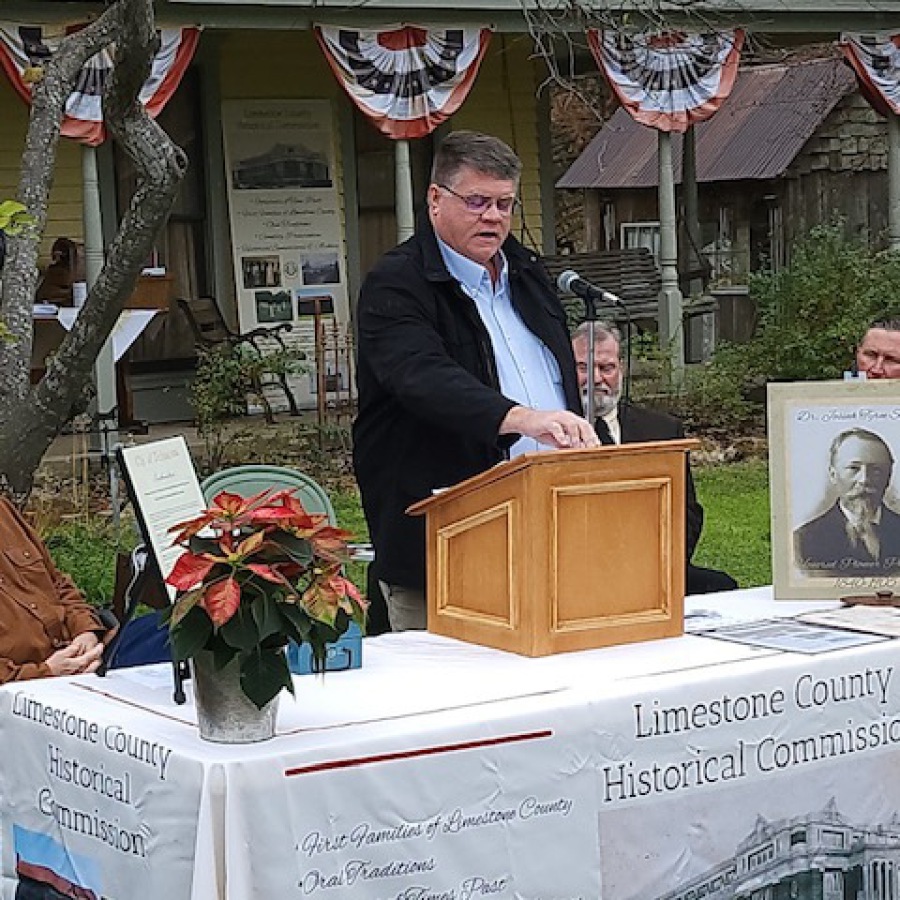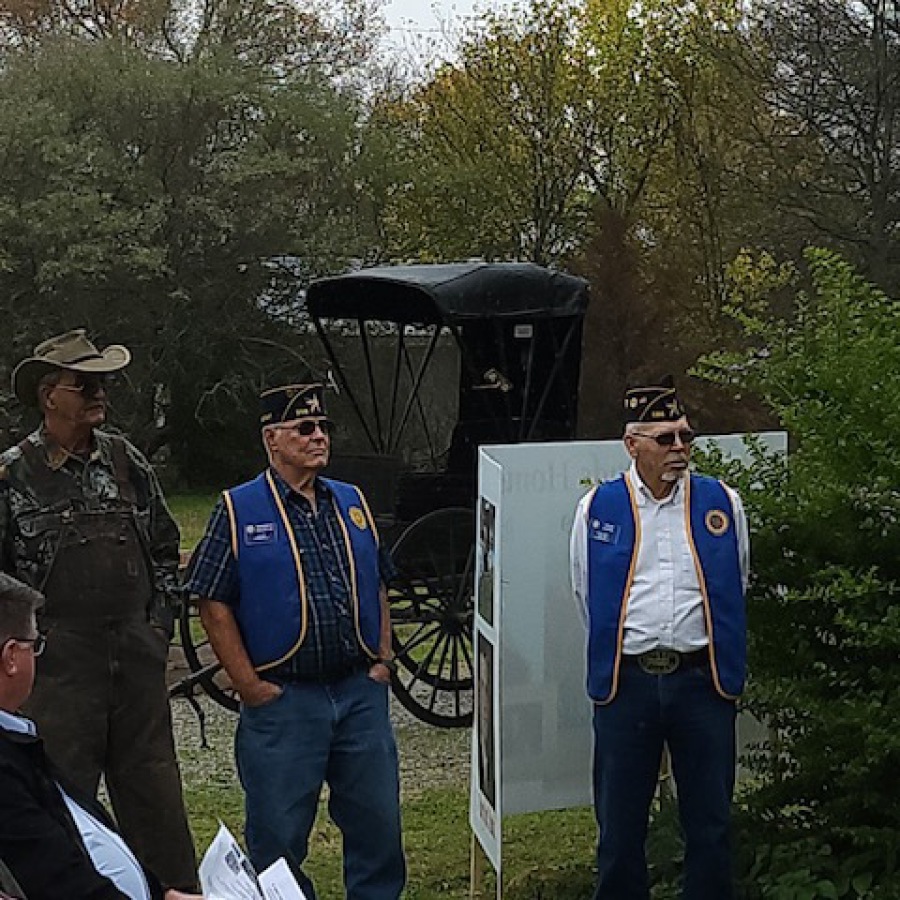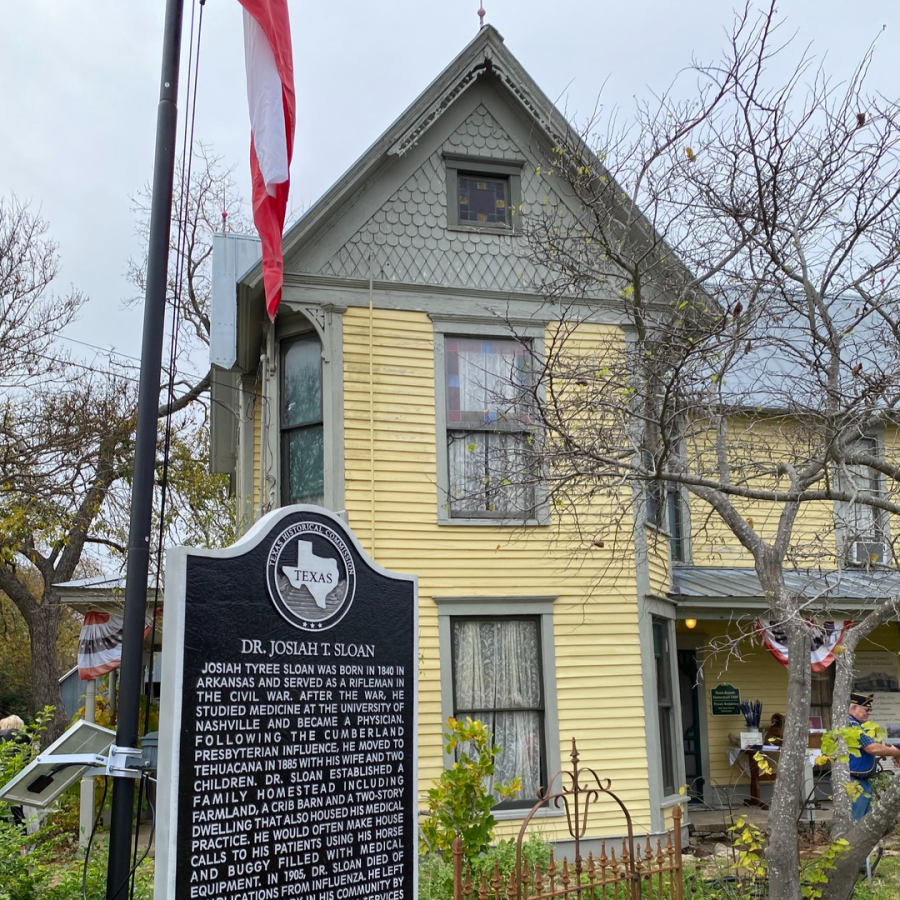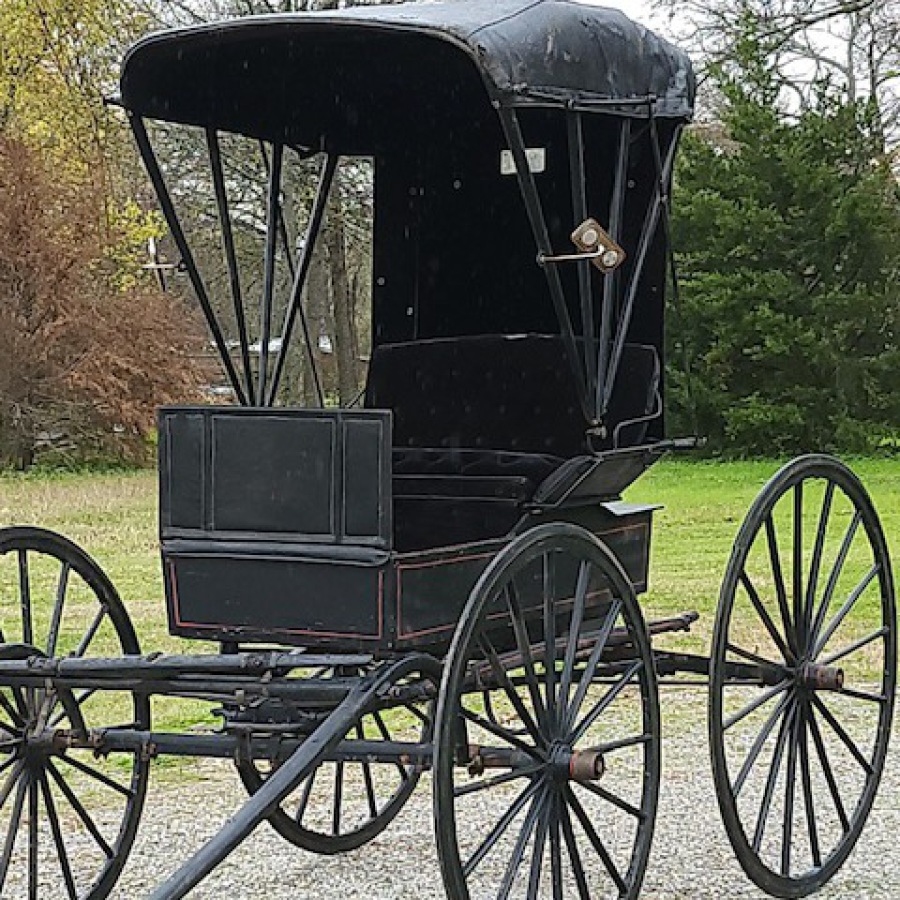Dr. Josiah T. Sloan
The Texas Historical Marker for Dr. Josiah T. Sloan in Tehuacana was dedicated in a ceremony on Sunday, December 4, 2022. Josiah Tyree Sloan was born in 1840 in Arkansas and served as a rifleman in the Civil War. After the war, he studied medicine at the University of Nashville and became a physician. Following the Cumberland Presbyterian influence, he moved to Tehuacana in 1885 with his wife and two children. Dr. Sloan established a family homestead including farmland, a crib barn, and a two-story dwelling that also housed his medical practice. He would often make house calls to his patients using his horse and buggy filled with medical equipment. In 1905, Dr. Sloan died of complications from influenza. He left an indelible mark in his community by providing invaluable medical services as a pioneer physician.
Narrative History
I. CONTEXT
The J. T. Sloan Homestead is one of the last of remaining in-tact homesteads in the
city limits of Tehuacana, Tx. It is equal in stature and reputation only to its original owner, builder, and entrepreneur, Dr. Josiah Tyree Sloan, pioneer Cumberland Presbyterian physician.
With it all comes a preserved example of Queen Anne Architecture, a fine example of a pioneer Crib barn, farmland, and a rich history of 140+ years. Located on Main Street and State Route
442 off of HWY 171 in Downtown Tehuacana, Texas. Tax Description of Homestead: No. R21110 BLOCK 024 TEHUACANA, LOT 007 - 010(W/8'), R135614 Block 24 TEHUACANA, LOT 010-012.
Positioned directly across from the once vibrant buildings of the downtown blocks of Tehuacana, the home was built and land purchased from Dr. J. L. Miles by Dr. Josiah Tyree
Sloan who moved to Tehuacana in 1885 to establish a livelihood and raise two children in a new settlement with higher education ideals as a member of the Cumberland Presbyterian Church.
Prominent in Limestone County records and census, Dr. Sloan is on record for delivering many children in the county. Regular visits into the larger town of Mexia were made note in the various
news pages during Dr. Sloan’s time (there were seven publications). The archived birth records at the Limestone County courthouse (previous years’ records laid victim to Limestone County’s original
courthouse fire) indicate that several babies in Tehuacana were born from 1903-1904, fourteen by Dr. J. T. Sloan. Notes recorded his final delivery on December 14, 1904 two months before
his death in February of the next year from the complications of influenza.
Entirely located within the city limits, the homestead property has prime rich, sandy soil (rare for Tehuacana’s terrain and known limestone rock prominence). Both
home and barn have been sufficiently preserved and stand as examples of primary upscale homestead life in Trinity University’s college town. It also included an honorable pioneer’s “horse and
buggy” doctor’s business and transportation hub for vehicles and livestock essential for rural medical survival. The acre of land behind the barn has been undeveloped farmland for livestock
throughout the years.
The two-story farmhouse, itself, is a textbook Queen Anne style farmhouse with modest, yet indicative features, facing the main thoroughfare. Characteristic gables,
windows to the ground, wrap-around porches, stained glass features, gingerbread and gable ornamentation all were considered “fancy” in its day. As it was used as a physician and surgeon’s
home and business, historian analysis has revealed signs to suggest the business was upstairs with front door access. In time to reflect the growth of the business, the home was redesigned with
prominences on the frontier skyline (three fireplaces and five gables). A 1902 Trinity University football team photo shot revealed the somewhat lonely Victorian home in the distance, no trees and no
neighboring structures. Historic finds to verify office and patient room location have been noted. The home was deeded to Kate Magnolia Sloan, the doctor’s daughter upon her father’s ironic
death from influenza. Kate, herself, was a graduate of Trinity University, with concentrated studies in music. Dr. Sloan, his wife and son are buried in the Historic Tehuacana
Cemetery with headstone designation worthy of Tehuacana’s Historic Cemetery.
In the 115 years since his death, the home and crib barn of Josiah T. Sloan still stand with original interiors, woodwork and features. They exist in Tehuacana’s
downtown area as a testament to the strength of the pioneer life and an example of prominent living in the late 19th century in a once booming college environment.
II. OVERVIEW
Before Dr. Sloan
In 1797, Philips Nolan, on a trading and mapping expedition under the direction of Vice-President Thomas Jefferson, discovered the Tehuacana Hills. The Tehuacana Indians
(Tonkawa Tribe), lived in the area for centuries with prolific spring water, sandy soil, and hilltop view. Unfortunately, Cherokee tribesman were responsible for the disappearance of the local
tribe from the area. Obtaining a land grant from the Mexican Government, Major John Boyd located his land in 1836 in Tehuacana. In 1847, after Indian Peace Treaties subsided, he and a few brave
settlers opened a post office and established a store.
Coming in a close third to Austin and Palestine in the vote for the capital of Texas, Tehuacana was a prime location for the Cumberland Presbyterians to begin and build a
university “where sin does not abound”. Trinity University opened its doors in 1869 as a co-educational liberal arts college and remained in the township of Tehuacana until 1902 when it moved to
Waxahachie, Texas. And so the spirited pioneers with visions of enlightenment in a “new frontier” came.
Civil War Connection
Josiah Tyree Sloan was born in 1840 in Dobeyville, Arkansas. Census shows he was still living with his parents and family in Clark Co., Arkansas in 1860. He
served in Flanigan’s 2nd Arkansas Infantry Company E and Army of the Trans Mississippi Dept. during the Civil War. After the war, Confederate soldiers were released to study fields of
interest. Family recollections informed us that the doctor “read medical papers” and studied medicine at the University of Nashville in Tennessee. He married Martha A. Cravens in 1867 and
was listed in the Arkansas IRS Records as Physician.
The family then moved to Tehuacana and bought the property on the west side of a dirt road, now called Main Street in downtown Tehuacana. He purchased a two-story four
room saltbox, cypress sided structure, (cypress sawmills already strong in existence in Groesbeck at the turn of the century) for $600 in 1885 from J. L. Miles, who in the 1880 Census was a
physician, as well, listed living in Ennis of Ellis County. Miles owned the property and “appenditures” since 1882, and was one of the direct grantees of the Trinity University’s Board of Trustees
land allotment to surrounding town members. Deeded to him by the Trinity University Trustees (T. W. Wade Properties), it is perceived that on Block 24 Dr. Miles built and lived in a smaller
structure while under his ownership as earlier unidentifiable structural clues for a smaller home was discovered butting up to the home by its current owner, Bill Ferris.
Dr. J. T. Sloan, "Office in Residence"
Our 1880’s “horse and buggy” doctor, Dr. Josiah T. Sloan, kept one carriage and horse according to the 1886 tax report in the current standing barn behind the home. By
1895 two wagons/carriages and three horses/mules were recorded. During his lifetime in Tehuacana, he kept cattle in lots 10, 11, and 12 behind the barn up to Wade Street. This is reported
in the 1895 Limestone Co. tax records a total of 5.
The barn on the Dr. J. T. Sloan Homestead property is a “Crib Barn”. Historically, crib barn form is a barn type significant in American agriculture. In the south,
crib barns were especially numerous in the Appalachian and Ozark Mountain States of North Carolina, Virginia, Kentucky, Tennessee and Arkansas, and the structure was brought to Texas by those
families experienced with their use and construction after the Civil War. Composed simply of two, four or sometimes six cribs that served as storage for fodder or pens for cattle or pigs, crib barns
may or may not have a hayloft above, but the Sloan Barn does.
In the Sloan Barn the cribs are separated by a central driveway running through the building, therefore, making it a double crib barn. The barn has its original stalls,
storage areas and doors. The two stalls are beside each other, original troughs in place, 3 doors original to the rooms. The doors and ladder to the hayloft are intact and are original. The second
story hayloft is over the ground floor, making hay available with little work for upstairs and downstairs loading unto wagons for use. The barn is to the west behind the home, on the south side, with
easy access to Main Street.
“Pioneer Entrepreneur”
Trinity University published their “Trinitonian Papers”, guidebooks, and bulletins each year of matriculation for Trinity’s students. They offered ads to the community
businesses for sponsorship. In a 1901 Trinitonian, Dr. Sloan presented an advertisement for his office and residence open “all hours” for the physician and surgeon. Medicine bottles
have been dug up in garden areas of the Sloan-Bounds property as proof to this practice. In the 1902 Trinitonian, the doctor was noted for a recipe of liver pills dubbed “Dr. Sloan’s Celebrated Liver
Pills”. His recipe was sold to the Tonkawa Drug Co. of Tehuacana. This drug company posted ads until 1907 in the county newspapers with sales of Dr. Sloan’s Liver Pills ‘for Biliousness
and all Liver Troubles’ for 25c per box. The ads further stated: (Liver Pills) “prescription first used in the swamps of Arkansas forty years ago….” The “Tonkawa Blue Powders” for ‘Wire Cuts or Sores
on Man or Beast’, however, sold for 50c a box. The (Powders) “keeps the flies away, and prevents the screw worm from doing its work.” The Tonkawa Drug Company, of Tehuacana, Tex., further
stated, “distributed- in restaurants, probably- a little envelope wherein two toothpicks are packed, and on the outside of which the following advertisement is printed: (Satisfaction inside after
eating a square meal. So, you feel after using the Tonkawa Blue Powder for wire cuts upon that good horse of yours. Buy it from, etc. etc.)”. An entire page dedicated to the Tonkawa Drug Co.
with the intent of the drug company for hiring mail order products, etc. was found in the Issue date of June 13, 1907 in the City of Mexia’s “The State Herald” newspaper). Subscription
sales boosted the business for all.
The Doctor's Family
Henry Donnell Sloan died while 14 years old in 1885, his wife, Martha, died in 1899. Dr. J. T., Martha, and Henry are buried in the Historic Tehuacana Cemetery. Dr.
J. T. Sloan never realized his son’s graduation from Trinity University, although his daughter, Kate Sloan is listed in Annual Bulletins for Trinity University and later in the Minutes of the Texas
State Teachers Association Eleventh Annual Session. The barn and home and property surrounding it was sold in 1905 by his daughter, Kate, then 36 who married Judge Graham of Corsicana.
She sold the home and its property to the Cumberland Presbyterian deacon, J. B. Mathis for $1400, who owned and lived in the home for almost fifteen years.
The Home’s Description
As Tehuacana’s original pioneer doctor, Dr. Sloan maintained an “Office in Residence” status while in his home. Two fireplaces are installed on the West side of the home,
still with original stone and structure. Two more rooms upstairs, one on the north side of the landing and one in the hall on the south side with access from the office were an early salt box style
floorplan. Several historians (Donald Rhodes, Texas Hall Restoration) and architectural enthusiasts have detailed the original floorplan to reflect Dr. Sloan’s medical practice in the home. The Dr.
J. T. Sloan home structure continues to have its original cypress siding on the old portion exterior, bead board lined halls, pocket doors, all porch posts, and original staircase. Many
of the local Tehuacana quarried “college stones” make up the pier and beam foundation for the home and its porches.
III. Historical/Cultural Significance
The Pioneer “Horse & Buggy” Doctor - Dr. Josiah T. Sloan
In the New South, the greatest shortage of all was in medical knowledge and training. Until the 1860’s—and in some sections long afterward—a frontier doctor was almost
any man who called himself one. It is a safe guess that not more than a fourth of them held degrees from medical schools. Most learned by the apprentice system, and some were self-taught,
"self-appointed healers who hung out their shingles when they “got the call.” Military surgeons also appreciated the importance of good water to good health, (Tehuacana’s natural springs benefiting
health as one of the reasons for John Boyd’s choice for settlement). The post hospitals and doctors’ homes often were the only medical facilities available. But most
medical treatment in 19th-century Texas occurred in the patient's home or the doctor's home or office. And so new settlements in Texas welcomed their designated doctor families, as did
Tehuacana.
Dr. Sloan called on his patients by horse, buggy, or train, carrying his equipment and medical supplies in his saddlebag or black grip. Dr. Josiah Tyree Sloan chose
Tehuacana and Trinity University’s education asset as the location to raise and educate his two children. With his experiences in the Civil War Military and medical school a new horizon brought
opportunity for a good life for his family in Limestone County. His life as one of “the pioneer physicians” in Tehuacana’s past is cherished today.
The history is itself the experiences and knowledge of a “horse and buggy” doctor in the expanding west. The application of dusting powders typical of Civil War treatments for antiseptic
(conjectured idioform powders), let alone the birthing and delivery, and even surgery in a home is a way of life not fathomable in the 21st century.
The great doctor gave Tehuacana a wonderful example of early Texan Queen Anne architecture. He provided a medical service for a thriving community of need. His home, as
many others in the community provided lodging for students and boarders in Trinity University’s early years. The educated supported his business as members of a joint church spiritually. He was
an example of staying power, though losing a son early and wife before the turn of the century. He continued to prosper until his early death of 64. His large home and grounds have
provided residence for several community leaders and their families who have made their mark in Tehuacana’s history.
